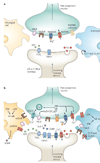Pathological and protective roles of glia in chronic pain
- PMID: 19096368
- PMCID: PMC2752436
- DOI: 10.1038/nrn2533
Pathological and protective roles of glia in chronic pain
Abstract
Glia have emerged as key contributors to pathological and chronic pain mechanisms. On activation, both astrocytes and microglia respond to and release a number of signalling molecules, which have protective and/or pathological functions. Here we review the current understanding of the contribution of glia to pathological pain and neuroprotection, and how the protective, anti-inflammatory actions of glia are being harnessed to develop new drug targets for neuropathic pain control. Given the prevalence of chronic pain and the partial efficacy of current drugs, which exclusively target neuronal mechanisms, new strategies to manipulate neuron-glia interactions in pain processing hold considerable promise.
Figures



References
-
- Carr DB, Goudas LC. Acute pain. Lancet. 1999;353:2051–2058. - PubMed
-
- Long DM, et al. Persistent back pain and sciatica in the United States: patient characteristics. J. Spinal Disord. 1996;9:40–58. - PubMed
-
- Woolf CJ, Ma Q. Nociceptors—noxious stimulus detectors. Neuron. 2007;55:353–364. - PubMed
-
- Hunt SP, Mantyh PW. The molecular dynamics of pain control. Nature Rev. Neurosci. 2001;2:83–91. - PubMed
Publication types
MeSH terms
Grants and funding
LinkOut - more resources
Full Text Sources
Other Literature Sources
Medical

